Socio-economic Determinants of Health in Penhill & Upper Stratton
VerifiedAdded on 2023/04/22
|20
|5560
|228
Essay
AI Summary
This essay analyzes healthcare issues in Penhill & Upper Stratton, a deprived area within the Swindon Borough Council in the UK. It focuses on the socio-economic and socio-cultural determinants of health, particularly childhood obesity and self-harm, which are prevalent concerns in the area. The essay examines the impact of these issues on individuals' health, comparing them with broader health and policy initiatives in England and Swindon. It discusses the significance of factors like lack of education, sedentary lifestyles, poverty, and gambling, and how they contribute to health inequalities. The essay also highlights the physiological, psychological, and social consequences of these health problems, and their economic impacts. Recommendations are provided to bring about behavioral changes and promote healthier living, contributing to improved public health outcomes within the community.
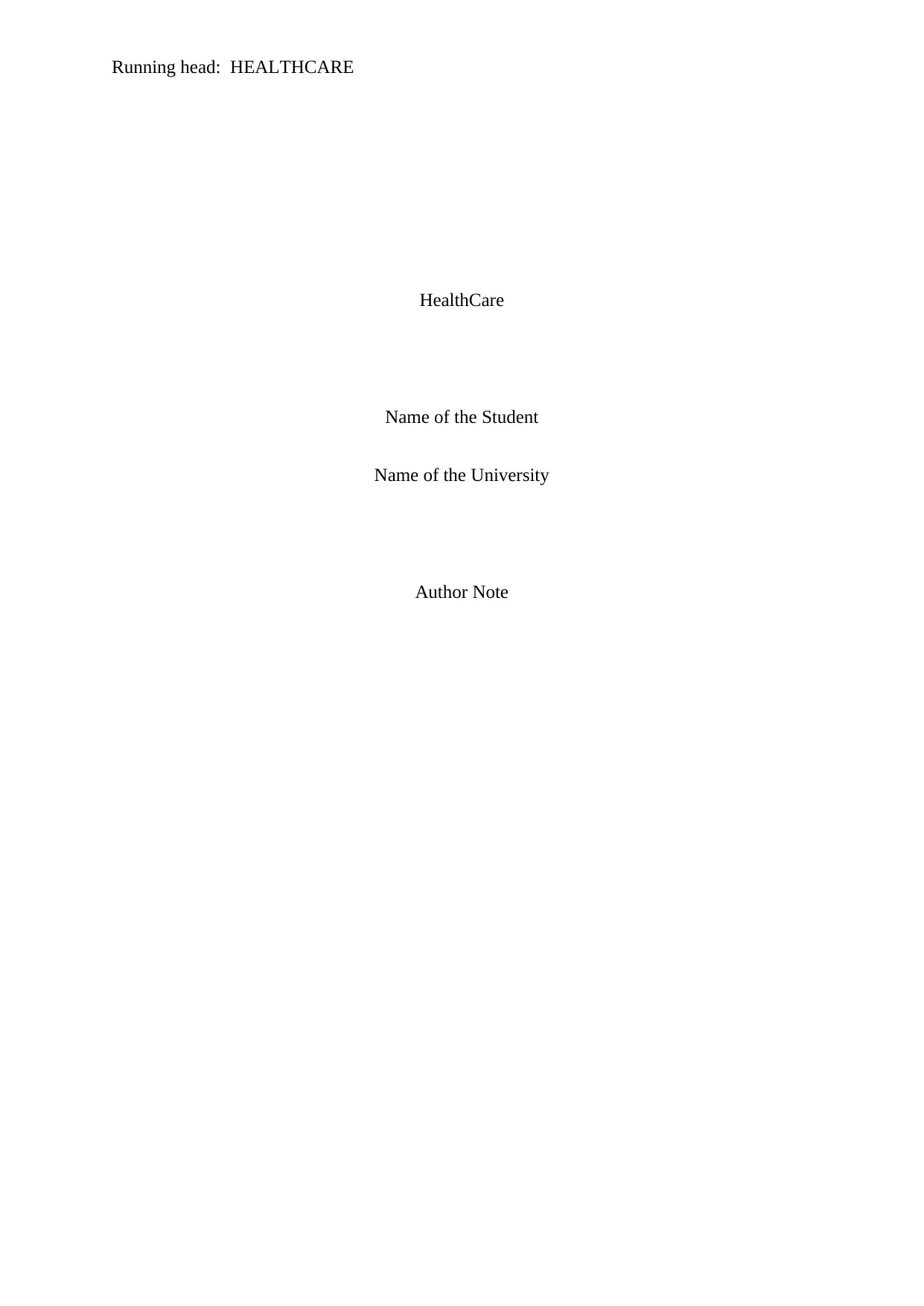
Running head: HEALTHCARE
HealthCare
Name of the Student
Name of the University
Author Note
HealthCare
Name of the Student
Name of the University
Author Note
Paraphrase This Document
Need a fresh take? Get an instant paraphrase of this document with our AI Paraphraser
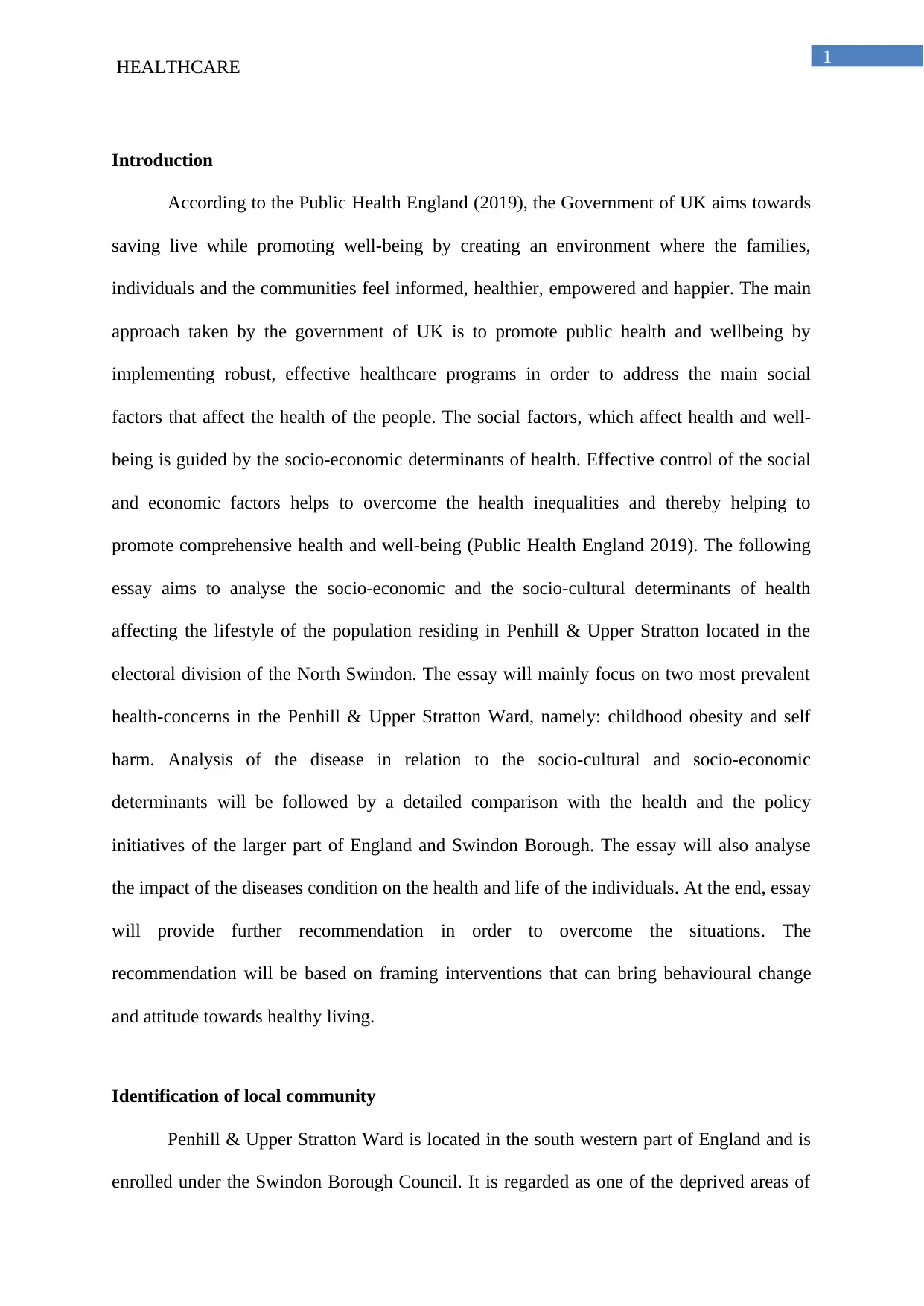
1
HEALTHCARE
Introduction
According to the Public Health England (2019), the Government of UK aims towards
saving live while promoting well-being by creating an environment where the families,
individuals and the communities feel informed, healthier, empowered and happier. The main
approach taken by the government of UK is to promote public health and wellbeing by
implementing robust, effective healthcare programs in order to address the main social
factors that affect the health of the people. The social factors, which affect health and well-
being is guided by the socio-economic determinants of health. Effective control of the social
and economic factors helps to overcome the health inequalities and thereby helping to
promote comprehensive health and well-being (Public Health England 2019). The following
essay aims to analyse the socio-economic and the socio-cultural determinants of health
affecting the lifestyle of the population residing in Penhill & Upper Stratton located in the
electoral division of the North Swindon. The essay will mainly focus on two most prevalent
health-concerns in the Penhill & Upper Stratton Ward, namely: childhood obesity and self
harm. Analysis of the disease in relation to the socio-cultural and socio-economic
determinants will be followed by a detailed comparison with the health and the policy
initiatives of the larger part of England and Swindon Borough. The essay will also analyse
the impact of the diseases condition on the health and life of the individuals. At the end, essay
will provide further recommendation in order to overcome the situations. The
recommendation will be based on framing interventions that can bring behavioural change
and attitude towards healthy living.
Identification of local community
Penhill & Upper Stratton Ward is located in the south western part of England and is
enrolled under the Swindon Borough Council. It is regarded as one of the deprived areas of
HEALTHCARE
Introduction
According to the Public Health England (2019), the Government of UK aims towards
saving live while promoting well-being by creating an environment where the families,
individuals and the communities feel informed, healthier, empowered and happier. The main
approach taken by the government of UK is to promote public health and wellbeing by
implementing robust, effective healthcare programs in order to address the main social
factors that affect the health of the people. The social factors, which affect health and well-
being is guided by the socio-economic determinants of health. Effective control of the social
and economic factors helps to overcome the health inequalities and thereby helping to
promote comprehensive health and well-being (Public Health England 2019). The following
essay aims to analyse the socio-economic and the socio-cultural determinants of health
affecting the lifestyle of the population residing in Penhill & Upper Stratton located in the
electoral division of the North Swindon. The essay will mainly focus on two most prevalent
health-concerns in the Penhill & Upper Stratton Ward, namely: childhood obesity and self
harm. Analysis of the disease in relation to the socio-cultural and socio-economic
determinants will be followed by a detailed comparison with the health and the policy
initiatives of the larger part of England and Swindon Borough. The essay will also analyse
the impact of the diseases condition on the health and life of the individuals. At the end, essay
will provide further recommendation in order to overcome the situations. The
recommendation will be based on framing interventions that can bring behavioural change
and attitude towards healthy living.
Identification of local community
Penhill & Upper Stratton Ward is located in the south western part of England and is
enrolled under the Swindon Borough Council. It is regarded as one of the deprived areas of
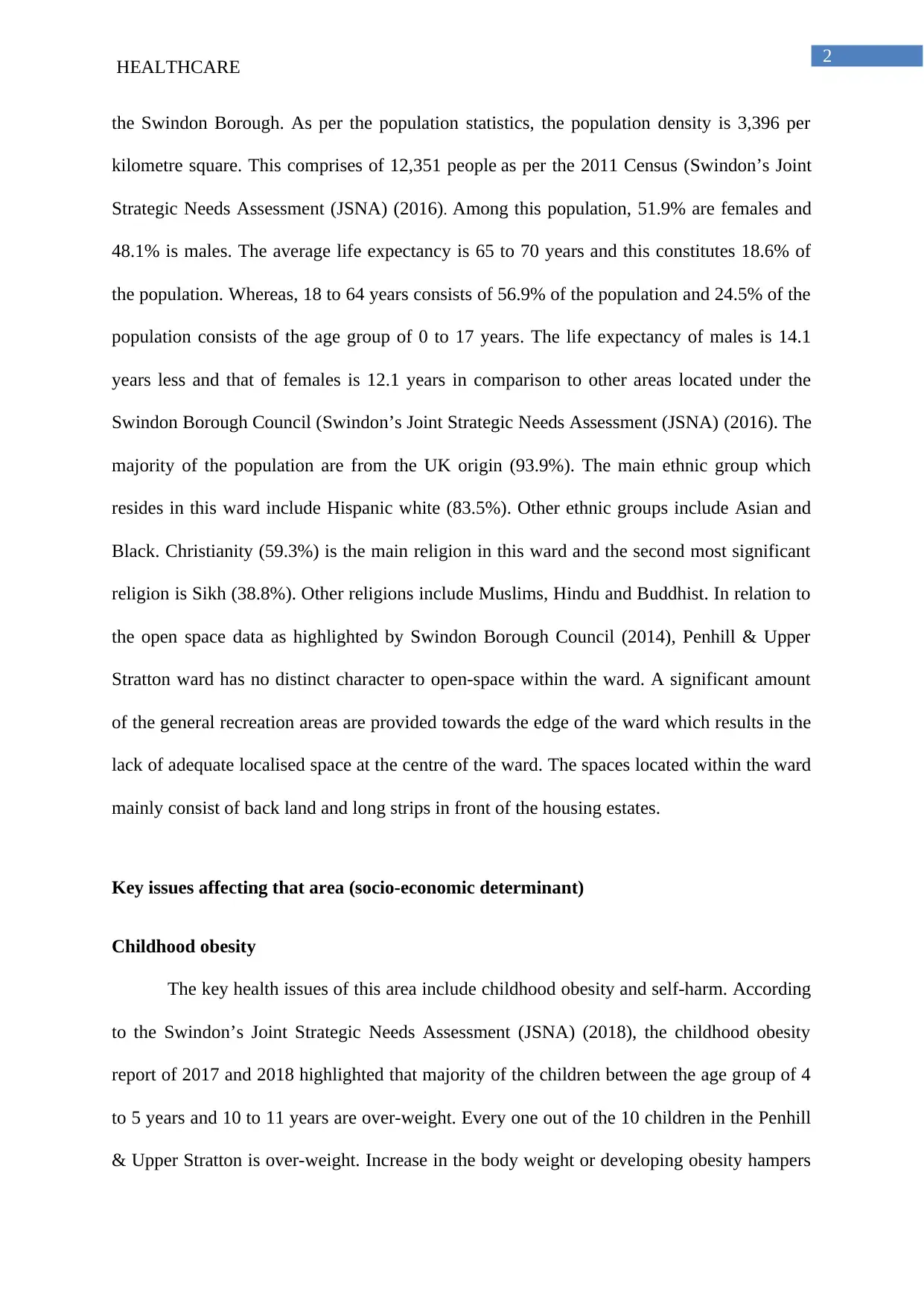
2
HEALTHCARE
the Swindon Borough. As per the population statistics, the population density is 3,396 per
kilometre square. This comprises of 12,351 people as per the 2011 Census (Swindon’s Joint
Strategic Needs Assessment (JSNA) (2016). Among this population, 51.9% are females and
48.1% is males. The average life expectancy is 65 to 70 years and this constitutes 18.6% of
the population. Whereas, 18 to 64 years consists of 56.9% of the population and 24.5% of the
population consists of the age group of 0 to 17 years. The life expectancy of males is 14.1
years less and that of females is 12.1 years in comparison to other areas located under the
Swindon Borough Council (Swindon’s Joint Strategic Needs Assessment (JSNA) (2016). The
majority of the population are from the UK origin (93.9%). The main ethnic group which
resides in this ward include Hispanic white (83.5%). Other ethnic groups include Asian and
Black. Christianity (59.3%) is the main religion in this ward and the second most significant
religion is Sikh (38.8%). Other religions include Muslims, Hindu and Buddhist. In relation to
the open space data as highlighted by Swindon Borough Council (2014), Penhill & Upper
Stratton ward has no distinct character to open-space within the ward. A significant amount
of the general recreation areas are provided towards the edge of the ward which results in the
lack of adequate localised space at the centre of the ward. The spaces located within the ward
mainly consist of back land and long strips in front of the housing estates.
Key issues affecting that area (socio-economic determinant)
Childhood obesity
The key health issues of this area include childhood obesity and self-harm. According
to the Swindon’s Joint Strategic Needs Assessment (JSNA) (2018), the childhood obesity
report of 2017 and 2018 highlighted that majority of the children between the age group of 4
to 5 years and 10 to 11 years are over-weight. Every one out of the 10 children in the Penhill
& Upper Stratton is over-weight. Increase in the body weight or developing obesity hampers
HEALTHCARE
the Swindon Borough. As per the population statistics, the population density is 3,396 per
kilometre square. This comprises of 12,351 people as per the 2011 Census (Swindon’s Joint
Strategic Needs Assessment (JSNA) (2016). Among this population, 51.9% are females and
48.1% is males. The average life expectancy is 65 to 70 years and this constitutes 18.6% of
the population. Whereas, 18 to 64 years consists of 56.9% of the population and 24.5% of the
population consists of the age group of 0 to 17 years. The life expectancy of males is 14.1
years less and that of females is 12.1 years in comparison to other areas located under the
Swindon Borough Council (Swindon’s Joint Strategic Needs Assessment (JSNA) (2016). The
majority of the population are from the UK origin (93.9%). The main ethnic group which
resides in this ward include Hispanic white (83.5%). Other ethnic groups include Asian and
Black. Christianity (59.3%) is the main religion in this ward and the second most significant
religion is Sikh (38.8%). Other religions include Muslims, Hindu and Buddhist. In relation to
the open space data as highlighted by Swindon Borough Council (2014), Penhill & Upper
Stratton ward has no distinct character to open-space within the ward. A significant amount
of the general recreation areas are provided towards the edge of the ward which results in the
lack of adequate localised space at the centre of the ward. The spaces located within the ward
mainly consist of back land and long strips in front of the housing estates.
Key issues affecting that area (socio-economic determinant)
Childhood obesity
The key health issues of this area include childhood obesity and self-harm. According
to the Swindon’s Joint Strategic Needs Assessment (JSNA) (2018), the childhood obesity
report of 2017 and 2018 highlighted that majority of the children between the age group of 4
to 5 years and 10 to 11 years are over-weight. Every one out of the 10 children in the Penhill
& Upper Stratton is over-weight. Increase in the body weight or developing obesity hampers
⊘ This is a preview!⊘
Do you want full access?
Subscribe today to unlock all pages.

Trusted by 1+ million students worldwide
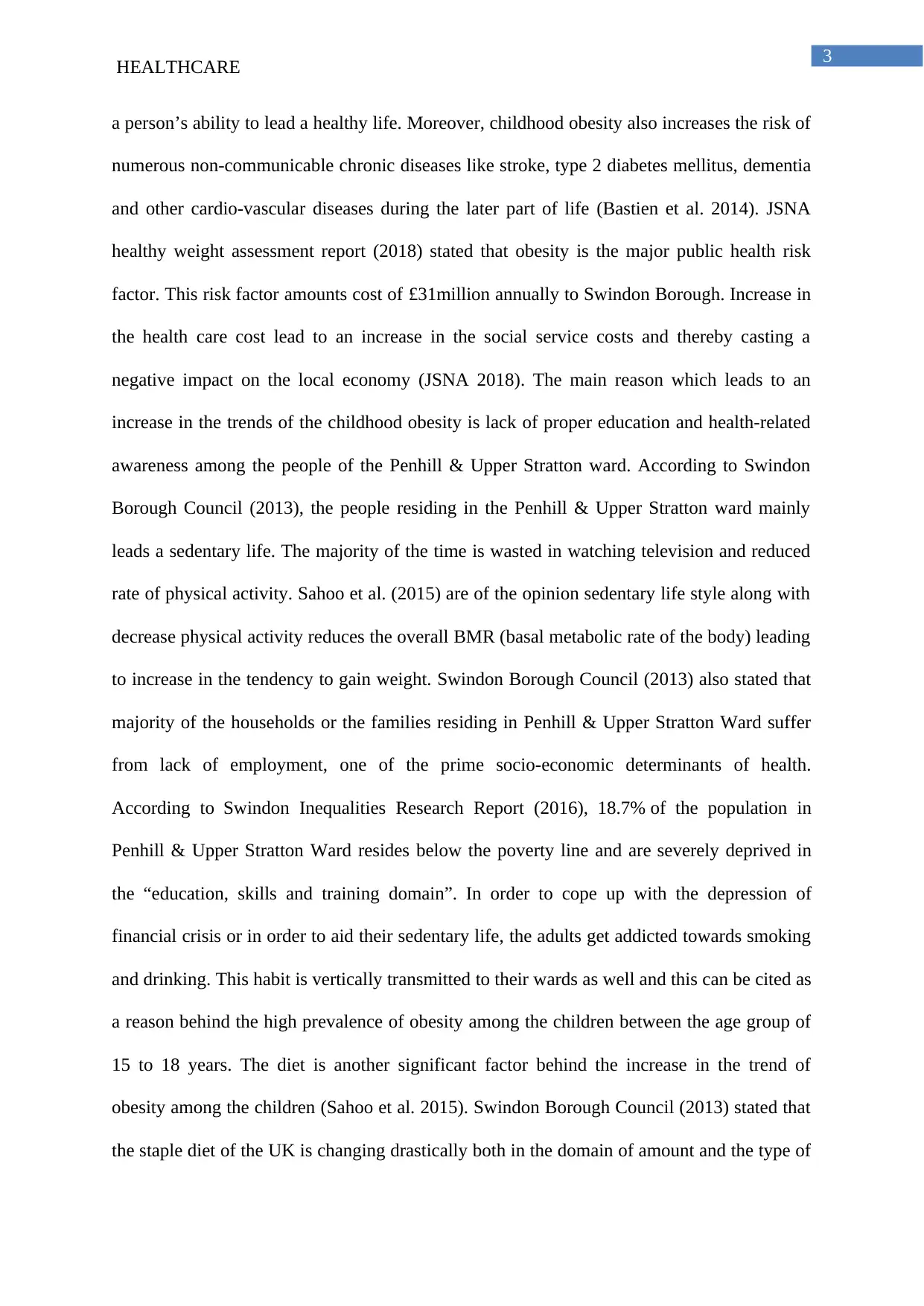
3
HEALTHCARE
a person’s ability to lead a healthy life. Moreover, childhood obesity also increases the risk of
numerous non-communicable chronic diseases like stroke, type 2 diabetes mellitus, dementia
and other cardio-vascular diseases during the later part of life (Bastien et al. 2014). JSNA
healthy weight assessment report (2018) stated that obesity is the major public health risk
factor. This risk factor amounts cost of £31million annually to Swindon Borough. Increase in
the health care cost lead to an increase in the social service costs and thereby casting a
negative impact on the local economy (JSNA 2018). The main reason which leads to an
increase in the trends of the childhood obesity is lack of proper education and health-related
awareness among the people of the Penhill & Upper Stratton ward. According to Swindon
Borough Council (2013), the people residing in the Penhill & Upper Stratton ward mainly
leads a sedentary life. The majority of the time is wasted in watching television and reduced
rate of physical activity. Sahoo et al. (2015) are of the opinion sedentary life style along with
decrease physical activity reduces the overall BMR (basal metabolic rate of the body) leading
to increase in the tendency to gain weight. Swindon Borough Council (2013) also stated that
majority of the households or the families residing in Penhill & Upper Stratton Ward suffer
from lack of employment, one of the prime socio-economic determinants of health.
According to Swindon Inequalities Research Report (2016), 18.7% of the population in
Penhill & Upper Stratton Ward resides below the poverty line and are severely deprived in
the “education, skills and training domain”. In order to cope up with the depression of
financial crisis or in order to aid their sedentary life, the adults get addicted towards smoking
and drinking. This habit is vertically transmitted to their wards as well and this can be cited as
a reason behind the high prevalence of obesity among the children between the age group of
15 to 18 years. The diet is another significant factor behind the increase in the trend of
obesity among the children (Sahoo et al. 2015). Swindon Borough Council (2013) stated that
the staple diet of the UK is changing drastically both in the domain of amount and the type of
HEALTHCARE
a person’s ability to lead a healthy life. Moreover, childhood obesity also increases the risk of
numerous non-communicable chronic diseases like stroke, type 2 diabetes mellitus, dementia
and other cardio-vascular diseases during the later part of life (Bastien et al. 2014). JSNA
healthy weight assessment report (2018) stated that obesity is the major public health risk
factor. This risk factor amounts cost of £31million annually to Swindon Borough. Increase in
the health care cost lead to an increase in the social service costs and thereby casting a
negative impact on the local economy (JSNA 2018). The main reason which leads to an
increase in the trends of the childhood obesity is lack of proper education and health-related
awareness among the people of the Penhill & Upper Stratton ward. According to Swindon
Borough Council (2013), the people residing in the Penhill & Upper Stratton ward mainly
leads a sedentary life. The majority of the time is wasted in watching television and reduced
rate of physical activity. Sahoo et al. (2015) are of the opinion sedentary life style along with
decrease physical activity reduces the overall BMR (basal metabolic rate of the body) leading
to increase in the tendency to gain weight. Swindon Borough Council (2013) also stated that
majority of the households or the families residing in Penhill & Upper Stratton Ward suffer
from lack of employment, one of the prime socio-economic determinants of health.
According to Swindon Inequalities Research Report (2016), 18.7% of the population in
Penhill & Upper Stratton Ward resides below the poverty line and are severely deprived in
the “education, skills and training domain”. In order to cope up with the depression of
financial crisis or in order to aid their sedentary life, the adults get addicted towards smoking
and drinking. This habit is vertically transmitted to their wards as well and this can be cited as
a reason behind the high prevalence of obesity among the children between the age group of
15 to 18 years. The diet is another significant factor behind the increase in the trend of
obesity among the children (Sahoo et al. 2015). Swindon Borough Council (2013) stated that
the staple diet of the UK is changing drastically both in the domain of amount and the type of
Paraphrase This Document
Need a fresh take? Get an instant paraphrase of this document with our AI Paraphraser
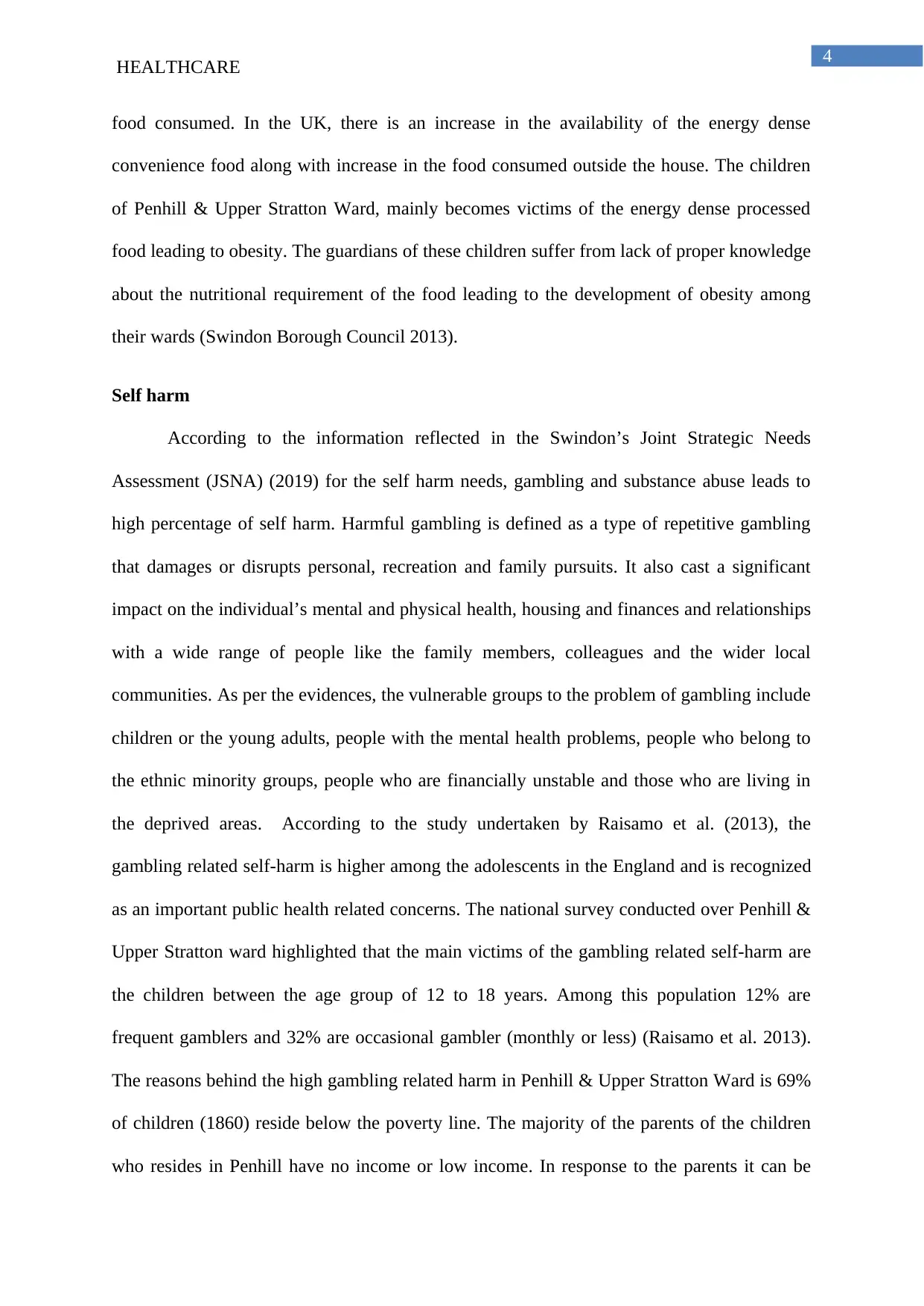
4
HEALTHCARE
food consumed. In the UK, there is an increase in the availability of the energy dense
convenience food along with increase in the food consumed outside the house. The children
of Penhill & Upper Stratton Ward, mainly becomes victims of the energy dense processed
food leading to obesity. The guardians of these children suffer from lack of proper knowledge
about the nutritional requirement of the food leading to the development of obesity among
their wards (Swindon Borough Council 2013).
Self harm
According to the information reflected in the Swindon’s Joint Strategic Needs
Assessment (JSNA) (2019) for the self harm needs, gambling and substance abuse leads to
high percentage of self harm. Harmful gambling is defined as a type of repetitive gambling
that damages or disrupts personal, recreation and family pursuits. It also cast a significant
impact on the individual’s mental and physical health, housing and finances and relationships
with a wide range of people like the family members, colleagues and the wider local
communities. As per the evidences, the vulnerable groups to the problem of gambling include
children or the young adults, people with the mental health problems, people who belong to
the ethnic minority groups, people who are financially unstable and those who are living in
the deprived areas. According to the study undertaken by Raisamo et al. (2013), the
gambling related self-harm is higher among the adolescents in the England and is recognized
as an important public health related concerns. The national survey conducted over Penhill &
Upper Stratton ward highlighted that the main victims of the gambling related self-harm are
the children between the age group of 12 to 18 years. Among this population 12% are
frequent gamblers and 32% are occasional gambler (monthly or less) (Raisamo et al. 2013).
The reasons behind the high gambling related harm in Penhill & Upper Stratton Ward is 69%
of children (1860) reside below the poverty line. The majority of the parents of the children
who resides in Penhill have no income or low income. In response to the parents it can be
HEALTHCARE
food consumed. In the UK, there is an increase in the availability of the energy dense
convenience food along with increase in the food consumed outside the house. The children
of Penhill & Upper Stratton Ward, mainly becomes victims of the energy dense processed
food leading to obesity. The guardians of these children suffer from lack of proper knowledge
about the nutritional requirement of the food leading to the development of obesity among
their wards (Swindon Borough Council 2013).
Self harm
According to the information reflected in the Swindon’s Joint Strategic Needs
Assessment (JSNA) (2019) for the self harm needs, gambling and substance abuse leads to
high percentage of self harm. Harmful gambling is defined as a type of repetitive gambling
that damages or disrupts personal, recreation and family pursuits. It also cast a significant
impact on the individual’s mental and physical health, housing and finances and relationships
with a wide range of people like the family members, colleagues and the wider local
communities. As per the evidences, the vulnerable groups to the problem of gambling include
children or the young adults, people with the mental health problems, people who belong to
the ethnic minority groups, people who are financially unstable and those who are living in
the deprived areas. According to the study undertaken by Raisamo et al. (2013), the
gambling related self-harm is higher among the adolescents in the England and is recognized
as an important public health related concerns. The national survey conducted over Penhill &
Upper Stratton ward highlighted that the main victims of the gambling related self-harm are
the children between the age group of 12 to 18 years. Among this population 12% are
frequent gamblers and 32% are occasional gambler (monthly or less) (Raisamo et al. 2013).
The reasons behind the high gambling related harm in Penhill & Upper Stratton Ward is 69%
of children (1860) reside below the poverty line. The majority of the parents of the children
who resides in Penhill have no income or low income. In response to the parents it can be
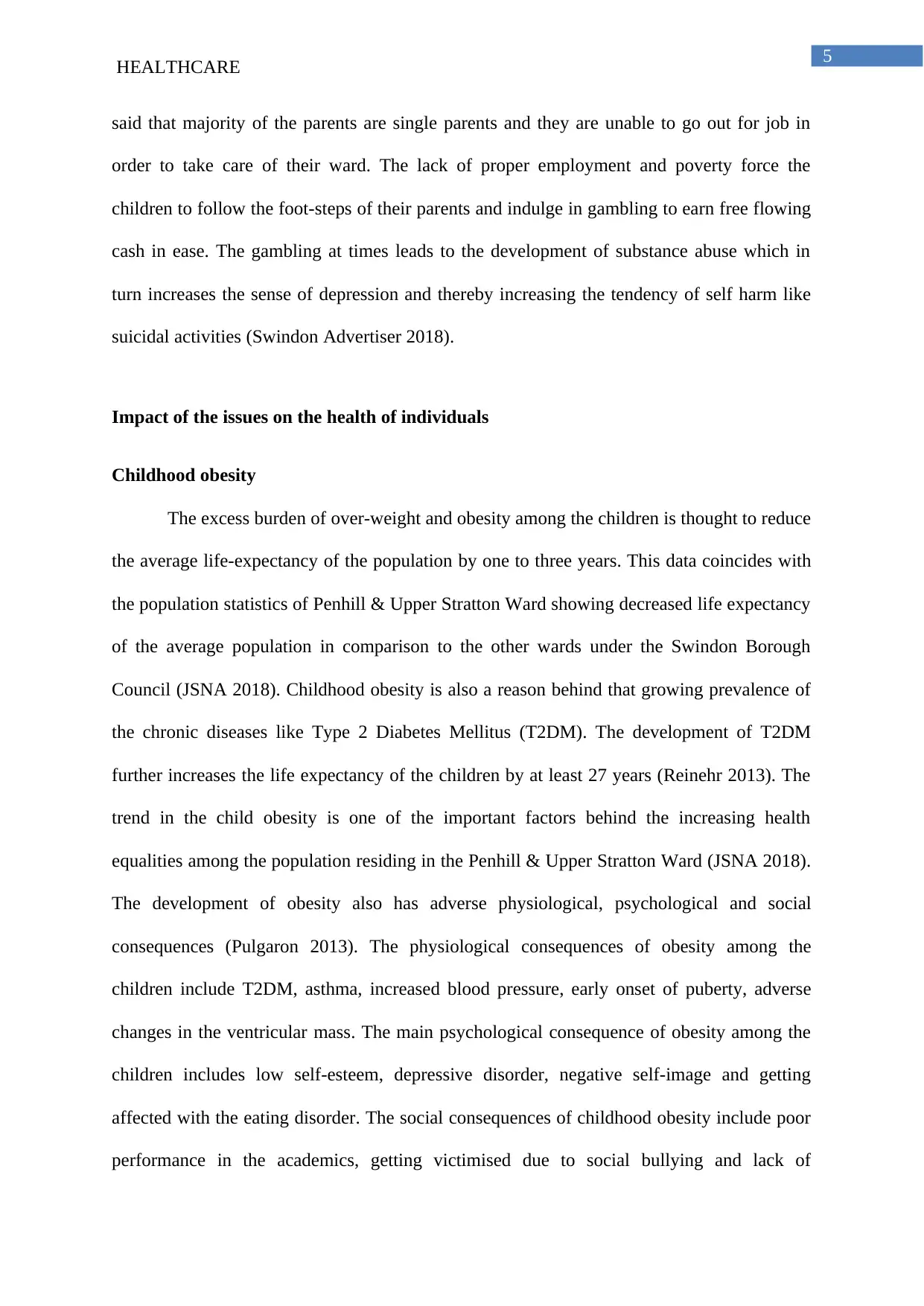
5
HEALTHCARE
said that majority of the parents are single parents and they are unable to go out for job in
order to take care of their ward. The lack of proper employment and poverty force the
children to follow the foot-steps of their parents and indulge in gambling to earn free flowing
cash in ease. The gambling at times leads to the development of substance abuse which in
turn increases the sense of depression and thereby increasing the tendency of self harm like
suicidal activities (Swindon Advertiser 2018).
Impact of the issues on the health of individuals
Childhood obesity
The excess burden of over-weight and obesity among the children is thought to reduce
the average life-expectancy of the population by one to three years. This data coincides with
the population statistics of Penhill & Upper Stratton Ward showing decreased life expectancy
of the average population in comparison to the other wards under the Swindon Borough
Council (JSNA 2018). Childhood obesity is also a reason behind that growing prevalence of
the chronic diseases like Type 2 Diabetes Mellitus (T2DM). The development of T2DM
further increases the life expectancy of the children by at least 27 years (Reinehr 2013). The
trend in the child obesity is one of the important factors behind the increasing health
equalities among the population residing in the Penhill & Upper Stratton Ward (JSNA 2018).
The development of obesity also has adverse physiological, psychological and social
consequences (Pulgaron 2013). The physiological consequences of obesity among the
children include T2DM, asthma, increased blood pressure, early onset of puberty, adverse
changes in the ventricular mass. The main psychological consequence of obesity among the
children includes low self-esteem, depressive disorder, negative self-image and getting
affected with the eating disorder. The social consequences of childhood obesity include poor
performance in the academics, getting victimised due to social bullying and lack of
HEALTHCARE
said that majority of the parents are single parents and they are unable to go out for job in
order to take care of their ward. The lack of proper employment and poverty force the
children to follow the foot-steps of their parents and indulge in gambling to earn free flowing
cash in ease. The gambling at times leads to the development of substance abuse which in
turn increases the sense of depression and thereby increasing the tendency of self harm like
suicidal activities (Swindon Advertiser 2018).
Impact of the issues on the health of individuals
Childhood obesity
The excess burden of over-weight and obesity among the children is thought to reduce
the average life-expectancy of the population by one to three years. This data coincides with
the population statistics of Penhill & Upper Stratton Ward showing decreased life expectancy
of the average population in comparison to the other wards under the Swindon Borough
Council (JSNA 2018). Childhood obesity is also a reason behind that growing prevalence of
the chronic diseases like Type 2 Diabetes Mellitus (T2DM). The development of T2DM
further increases the life expectancy of the children by at least 27 years (Reinehr 2013). The
trend in the child obesity is one of the important factors behind the increasing health
equalities among the population residing in the Penhill & Upper Stratton Ward (JSNA 2018).
The development of obesity also has adverse physiological, psychological and social
consequences (Pulgaron 2013). The physiological consequences of obesity among the
children include T2DM, asthma, increased blood pressure, early onset of puberty, adverse
changes in the ventricular mass. The main psychological consequence of obesity among the
children includes low self-esteem, depressive disorder, negative self-image and getting
affected with the eating disorder. The social consequences of childhood obesity include poor
performance in the academics, getting victimised due to social bullying and lack of
⊘ This is a preview!⊘
Do you want full access?
Subscribe today to unlock all pages.

Trusted by 1+ million students worldwide
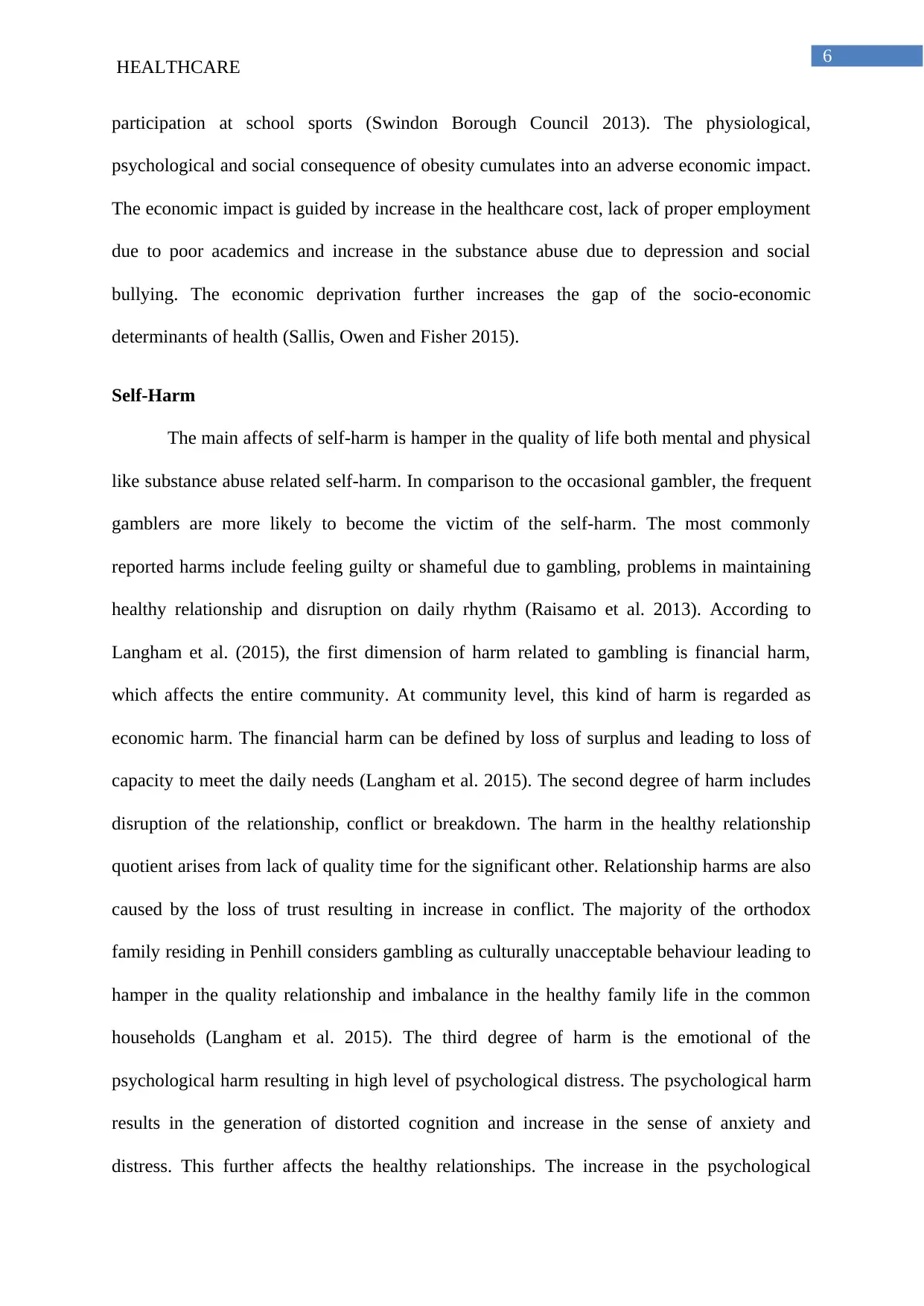
6
HEALTHCARE
participation at school sports (Swindon Borough Council 2013). The physiological,
psychological and social consequence of obesity cumulates into an adverse economic impact.
The economic impact is guided by increase in the healthcare cost, lack of proper employment
due to poor academics and increase in the substance abuse due to depression and social
bullying. The economic deprivation further increases the gap of the socio-economic
determinants of health (Sallis, Owen and Fisher 2015).
Self-Harm
The main affects of self-harm is hamper in the quality of life both mental and physical
like substance abuse related self-harm. In comparison to the occasional gambler, the frequent
gamblers are more likely to become the victim of the self-harm. The most commonly
reported harms include feeling guilty or shameful due to gambling, problems in maintaining
healthy relationship and disruption on daily rhythm (Raisamo et al. 2013). According to
Langham et al. (2015), the first dimension of harm related to gambling is financial harm,
which affects the entire community. At community level, this kind of harm is regarded as
economic harm. The financial harm can be defined by loss of surplus and leading to loss of
capacity to meet the daily needs (Langham et al. 2015). The second degree of harm includes
disruption of the relationship, conflict or breakdown. The harm in the healthy relationship
quotient arises from lack of quality time for the significant other. Relationship harms are also
caused by the loss of trust resulting in increase in conflict. The majority of the orthodox
family residing in Penhill considers gambling as culturally unacceptable behaviour leading to
hamper in the quality relationship and imbalance in the healthy family life in the common
households (Langham et al. 2015). The third degree of harm is the emotional of the
psychological harm resulting in high level of psychological distress. The psychological harm
results in the generation of distorted cognition and increase in the sense of anxiety and
distress. This further affects the healthy relationships. The increase in the psychological
HEALTHCARE
participation at school sports (Swindon Borough Council 2013). The physiological,
psychological and social consequence of obesity cumulates into an adverse economic impact.
The economic impact is guided by increase in the healthcare cost, lack of proper employment
due to poor academics and increase in the substance abuse due to depression and social
bullying. The economic deprivation further increases the gap of the socio-economic
determinants of health (Sallis, Owen and Fisher 2015).
Self-Harm
The main affects of self-harm is hamper in the quality of life both mental and physical
like substance abuse related self-harm. In comparison to the occasional gambler, the frequent
gamblers are more likely to become the victim of the self-harm. The most commonly
reported harms include feeling guilty or shameful due to gambling, problems in maintaining
healthy relationship and disruption on daily rhythm (Raisamo et al. 2013). According to
Langham et al. (2015), the first dimension of harm related to gambling is financial harm,
which affects the entire community. At community level, this kind of harm is regarded as
economic harm. The financial harm can be defined by loss of surplus and leading to loss of
capacity to meet the daily needs (Langham et al. 2015). The second degree of harm includes
disruption of the relationship, conflict or breakdown. The harm in the healthy relationship
quotient arises from lack of quality time for the significant other. Relationship harms are also
caused by the loss of trust resulting in increase in conflict. The majority of the orthodox
family residing in Penhill considers gambling as culturally unacceptable behaviour leading to
hamper in the quality relationship and imbalance in the healthy family life in the common
households (Langham et al. 2015). The third degree of harm is the emotional of the
psychological harm resulting in high level of psychological distress. The psychological harm
results in the generation of distorted cognition and increase in the sense of anxiety and
distress. This further affects the healthy relationships. The increase in the psychological
Paraphrase This Document
Need a fresh take? Get an instant paraphrase of this document with our AI Paraphraser
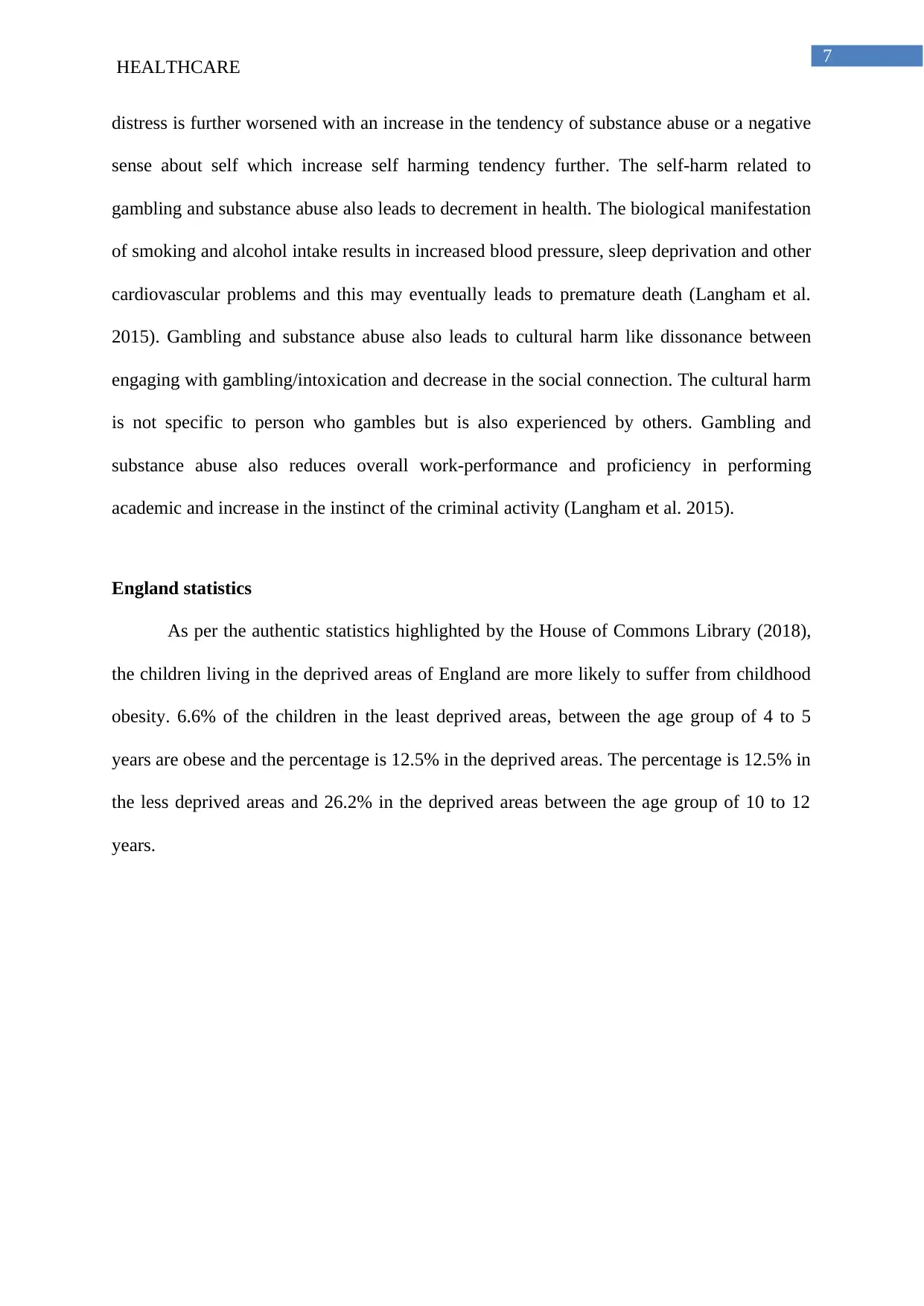
7
HEALTHCARE
distress is further worsened with an increase in the tendency of substance abuse or a negative
sense about self which increase self harming tendency further. The self-harm related to
gambling and substance abuse also leads to decrement in health. The biological manifestation
of smoking and alcohol intake results in increased blood pressure, sleep deprivation and other
cardiovascular problems and this may eventually leads to premature death (Langham et al.
2015). Gambling and substance abuse also leads to cultural harm like dissonance between
engaging with gambling/intoxication and decrease in the social connection. The cultural harm
is not specific to person who gambles but is also experienced by others. Gambling and
substance abuse also reduces overall work-performance and proficiency in performing
academic and increase in the instinct of the criminal activity (Langham et al. 2015).
England statistics
As per the authentic statistics highlighted by the House of Commons Library (2018),
the children living in the deprived areas of England are more likely to suffer from childhood
obesity. 6.6% of the children in the least deprived areas, between the age group of 4 to 5
years are obese and the percentage is 12.5% in the deprived areas. The percentage is 12.5% in
the less deprived areas and 26.2% in the deprived areas between the age group of 10 to 12
years.
HEALTHCARE
distress is further worsened with an increase in the tendency of substance abuse or a negative
sense about self which increase self harming tendency further. The self-harm related to
gambling and substance abuse also leads to decrement in health. The biological manifestation
of smoking and alcohol intake results in increased blood pressure, sleep deprivation and other
cardiovascular problems and this may eventually leads to premature death (Langham et al.
2015). Gambling and substance abuse also leads to cultural harm like dissonance between
engaging with gambling/intoxication and decrease in the social connection. The cultural harm
is not specific to person who gambles but is also experienced by others. Gambling and
substance abuse also reduces overall work-performance and proficiency in performing
academic and increase in the instinct of the criminal activity (Langham et al. 2015).
England statistics
As per the authentic statistics highlighted by the House of Commons Library (2018),
the children living in the deprived areas of England are more likely to suffer from childhood
obesity. 6.6% of the children in the least deprived areas, between the age group of 4 to 5
years are obese and the percentage is 12.5% in the deprived areas. The percentage is 12.5% in
the less deprived areas and 26.2% in the deprived areas between the age group of 10 to 12
years.
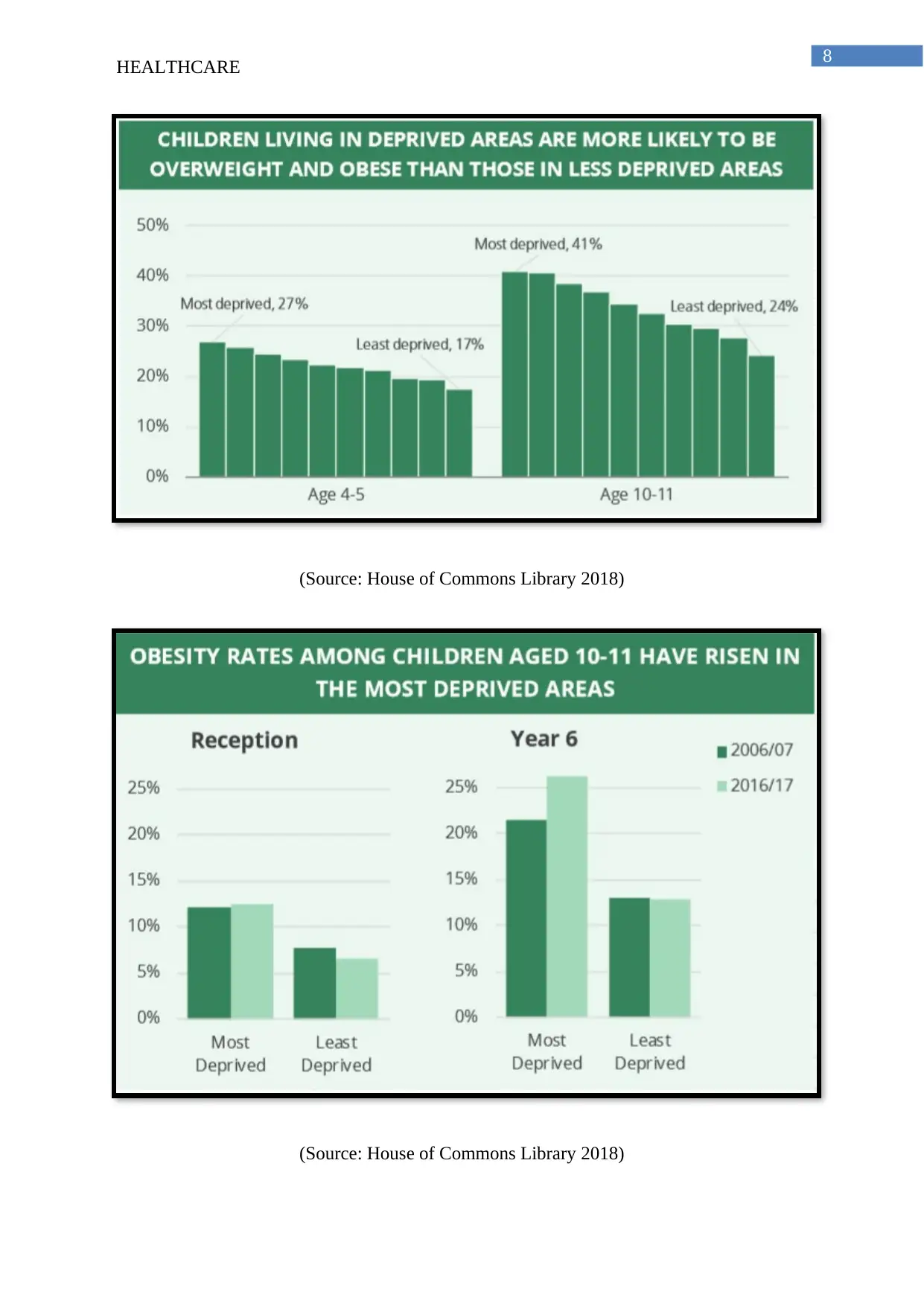
8
HEALTHCARE
(Source: House of Commons Library 2018)
(Source: House of Commons Library 2018)
HEALTHCARE
(Source: House of Commons Library 2018)
(Source: House of Commons Library 2018)
⊘ This is a preview!⊘
Do you want full access?
Subscribe today to unlock all pages.

Trusted by 1+ million students worldwide
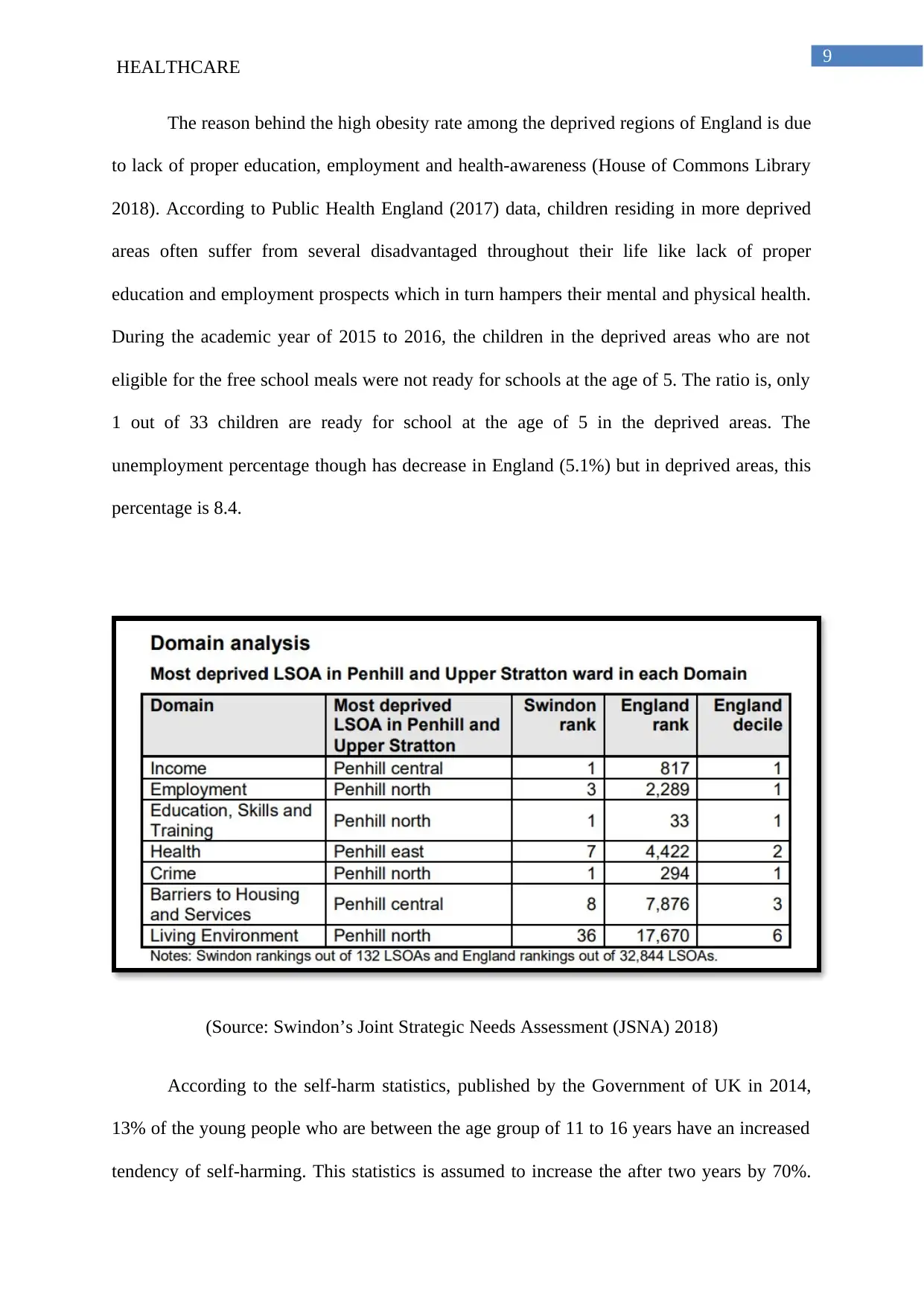
9
HEALTHCARE
The reason behind the high obesity rate among the deprived regions of England is due
to lack of proper education, employment and health-awareness (House of Commons Library
2018). According to Public Health England (2017) data, children residing in more deprived
areas often suffer from several disadvantaged throughout their life like lack of proper
education and employment prospects which in turn hampers their mental and physical health.
During the academic year of 2015 to 2016, the children in the deprived areas who are not
eligible for the free school meals were not ready for schools at the age of 5. The ratio is, only
1 out of 33 children are ready for school at the age of 5 in the deprived areas. The
unemployment percentage though has decrease in England (5.1%) but in deprived areas, this
percentage is 8.4.
(Source: Swindon’s Joint Strategic Needs Assessment (JSNA) 2018)
According to the self-harm statistics, published by the Government of UK in 2014,
13% of the young people who are between the age group of 11 to 16 years have an increased
tendency of self-harming. This statistics is assumed to increase the after two years by 70%.
HEALTHCARE
The reason behind the high obesity rate among the deprived regions of England is due
to lack of proper education, employment and health-awareness (House of Commons Library
2018). According to Public Health England (2017) data, children residing in more deprived
areas often suffer from several disadvantaged throughout their life like lack of proper
education and employment prospects which in turn hampers their mental and physical health.
During the academic year of 2015 to 2016, the children in the deprived areas who are not
eligible for the free school meals were not ready for schools at the age of 5. The ratio is, only
1 out of 33 children are ready for school at the age of 5 in the deprived areas. The
unemployment percentage though has decrease in England (5.1%) but in deprived areas, this
percentage is 8.4.
(Source: Swindon’s Joint Strategic Needs Assessment (JSNA) 2018)
According to the self-harm statistics, published by the Government of UK in 2014,
13% of the young people who are between the age group of 11 to 16 years have an increased
tendency of self-harming. This statistics is assumed to increase the after two years by 70%.
Paraphrase This Document
Need a fresh take? Get an instant paraphrase of this document with our AI Paraphraser
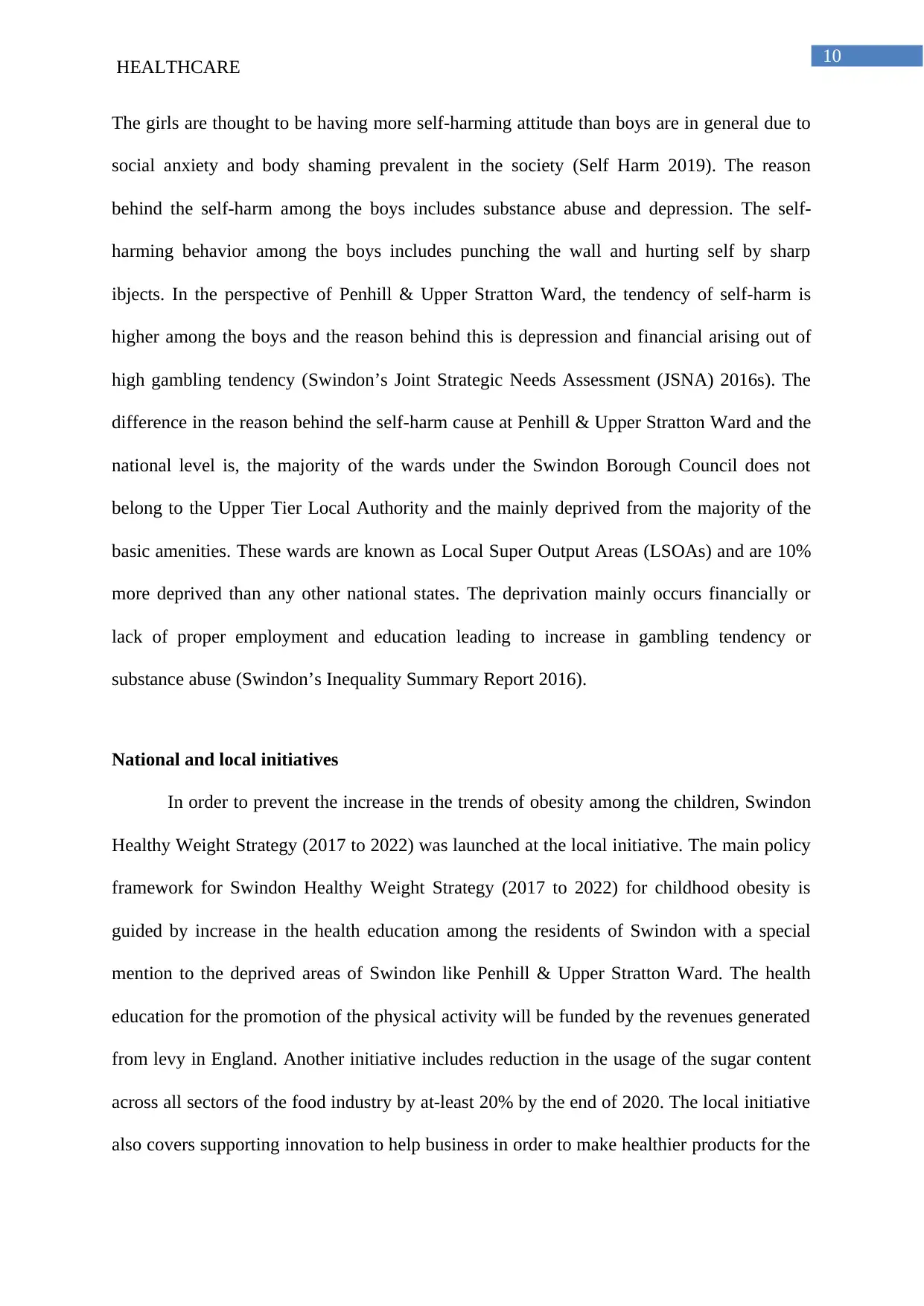
10
HEALTHCARE
The girls are thought to be having more self-harming attitude than boys are in general due to
social anxiety and body shaming prevalent in the society (Self Harm 2019). The reason
behind the self-harm among the boys includes substance abuse and depression. The self-
harming behavior among the boys includes punching the wall and hurting self by sharp
ibjects. In the perspective of Penhill & Upper Stratton Ward, the tendency of self-harm is
higher among the boys and the reason behind this is depression and financial arising out of
high gambling tendency (Swindon’s Joint Strategic Needs Assessment (JSNA) 2016s). The
difference in the reason behind the self-harm cause at Penhill & Upper Stratton Ward and the
national level is, the majority of the wards under the Swindon Borough Council does not
belong to the Upper Tier Local Authority and the mainly deprived from the majority of the
basic amenities. These wards are known as Local Super Output Areas (LSOAs) and are 10%
more deprived than any other national states. The deprivation mainly occurs financially or
lack of proper employment and education leading to increase in gambling tendency or
substance abuse (Swindon’s Inequality Summary Report 2016).
National and local initiatives
In order to prevent the increase in the trends of obesity among the children, Swindon
Healthy Weight Strategy (2017 to 2022) was launched at the local initiative. The main policy
framework for Swindon Healthy Weight Strategy (2017 to 2022) for childhood obesity is
guided by increase in the health education among the residents of Swindon with a special
mention to the deprived areas of Swindon like Penhill & Upper Stratton Ward. The health
education for the promotion of the physical activity will be funded by the revenues generated
from levy in England. Another initiative includes reduction in the usage of the sugar content
across all sectors of the food industry by at-least 20% by the end of 2020. The local initiative
also covers supporting innovation to help business in order to make healthier products for the
HEALTHCARE
The girls are thought to be having more self-harming attitude than boys are in general due to
social anxiety and body shaming prevalent in the society (Self Harm 2019). The reason
behind the self-harm among the boys includes substance abuse and depression. The self-
harming behavior among the boys includes punching the wall and hurting self by sharp
ibjects. In the perspective of Penhill & Upper Stratton Ward, the tendency of self-harm is
higher among the boys and the reason behind this is depression and financial arising out of
high gambling tendency (Swindon’s Joint Strategic Needs Assessment (JSNA) 2016s). The
difference in the reason behind the self-harm cause at Penhill & Upper Stratton Ward and the
national level is, the majority of the wards under the Swindon Borough Council does not
belong to the Upper Tier Local Authority and the mainly deprived from the majority of the
basic amenities. These wards are known as Local Super Output Areas (LSOAs) and are 10%
more deprived than any other national states. The deprivation mainly occurs financially or
lack of proper employment and education leading to increase in gambling tendency or
substance abuse (Swindon’s Inequality Summary Report 2016).
National and local initiatives
In order to prevent the increase in the trends of obesity among the children, Swindon
Healthy Weight Strategy (2017 to 2022) was launched at the local initiative. The main policy
framework for Swindon Healthy Weight Strategy (2017 to 2022) for childhood obesity is
guided by increase in the health education among the residents of Swindon with a special
mention to the deprived areas of Swindon like Penhill & Upper Stratton Ward. The health
education for the promotion of the physical activity will be funded by the revenues generated
from levy in England. Another initiative includes reduction in the usage of the sugar content
across all sectors of the food industry by at-least 20% by the end of 2020. The local initiative
also covers supporting innovation to help business in order to make healthier products for the
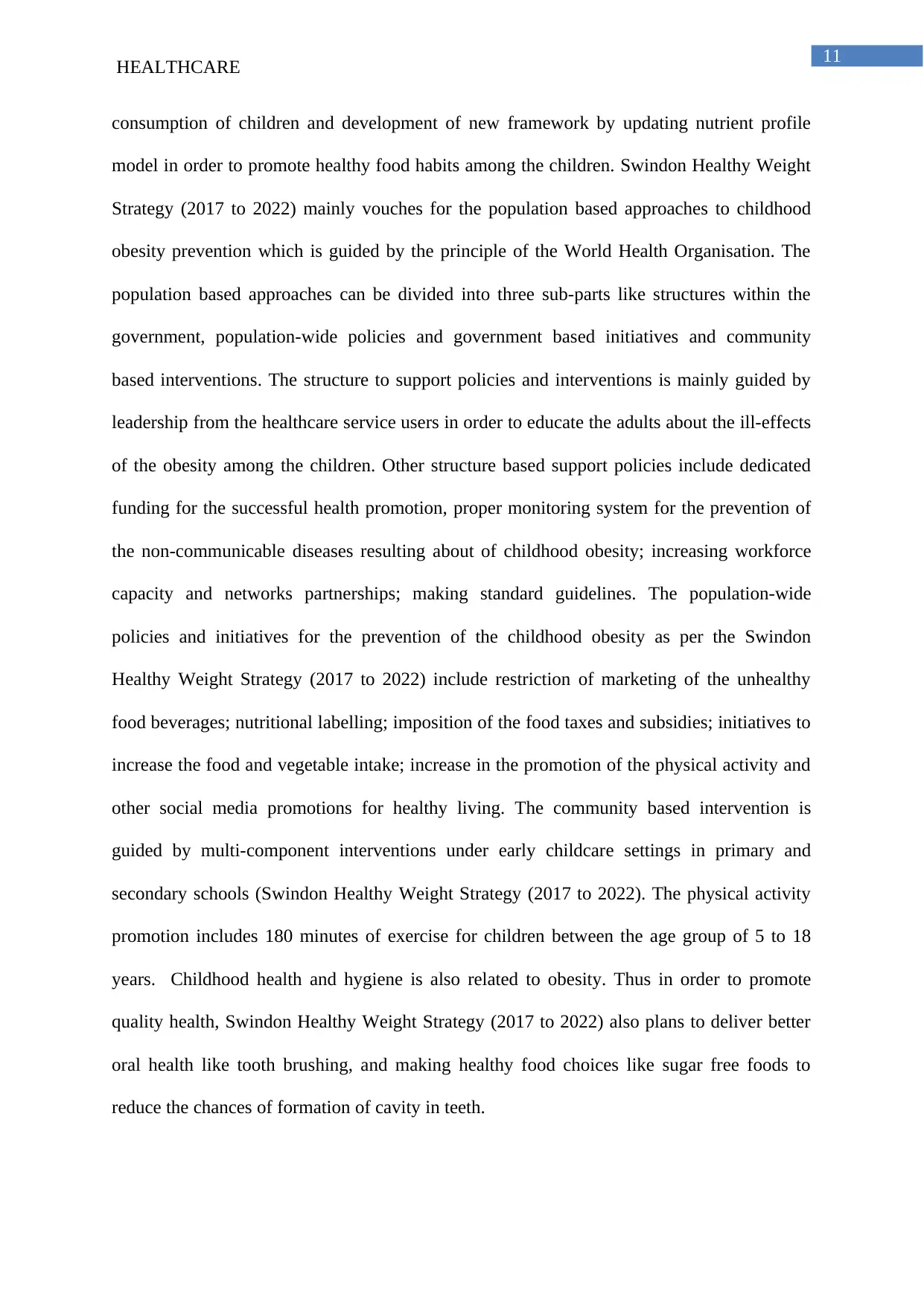
11
HEALTHCARE
consumption of children and development of new framework by updating nutrient profile
model in order to promote healthy food habits among the children. Swindon Healthy Weight
Strategy (2017 to 2022) mainly vouches for the population based approaches to childhood
obesity prevention which is guided by the principle of the World Health Organisation. The
population based approaches can be divided into three sub-parts like structures within the
government, population-wide policies and government based initiatives and community
based interventions. The structure to support policies and interventions is mainly guided by
leadership from the healthcare service users in order to educate the adults about the ill-effects
of the obesity among the children. Other structure based support policies include dedicated
funding for the successful health promotion, proper monitoring system for the prevention of
the non-communicable diseases resulting about of childhood obesity; increasing workforce
capacity and networks partnerships; making standard guidelines. The population-wide
policies and initiatives for the prevention of the childhood obesity as per the Swindon
Healthy Weight Strategy (2017 to 2022) include restriction of marketing of the unhealthy
food beverages; nutritional labelling; imposition of the food taxes and subsidies; initiatives to
increase the food and vegetable intake; increase in the promotion of the physical activity and
other social media promotions for healthy living. The community based intervention is
guided by multi-component interventions under early childcare settings in primary and
secondary schools (Swindon Healthy Weight Strategy (2017 to 2022). The physical activity
promotion includes 180 minutes of exercise for children between the age group of 5 to 18
years. Childhood health and hygiene is also related to obesity. Thus in order to promote
quality health, Swindon Healthy Weight Strategy (2017 to 2022) also plans to deliver better
oral health like tooth brushing, and making healthy food choices like sugar free foods to
reduce the chances of formation of cavity in teeth.
HEALTHCARE
consumption of children and development of new framework by updating nutrient profile
model in order to promote healthy food habits among the children. Swindon Healthy Weight
Strategy (2017 to 2022) mainly vouches for the population based approaches to childhood
obesity prevention which is guided by the principle of the World Health Organisation. The
population based approaches can be divided into three sub-parts like structures within the
government, population-wide policies and government based initiatives and community
based interventions. The structure to support policies and interventions is mainly guided by
leadership from the healthcare service users in order to educate the adults about the ill-effects
of the obesity among the children. Other structure based support policies include dedicated
funding for the successful health promotion, proper monitoring system for the prevention of
the non-communicable diseases resulting about of childhood obesity; increasing workforce
capacity and networks partnerships; making standard guidelines. The population-wide
policies and initiatives for the prevention of the childhood obesity as per the Swindon
Healthy Weight Strategy (2017 to 2022) include restriction of marketing of the unhealthy
food beverages; nutritional labelling; imposition of the food taxes and subsidies; initiatives to
increase the food and vegetable intake; increase in the promotion of the physical activity and
other social media promotions for healthy living. The community based intervention is
guided by multi-component interventions under early childcare settings in primary and
secondary schools (Swindon Healthy Weight Strategy (2017 to 2022). The physical activity
promotion includes 180 minutes of exercise for children between the age group of 5 to 18
years. Childhood health and hygiene is also related to obesity. Thus in order to promote
quality health, Swindon Healthy Weight Strategy (2017 to 2022) also plans to deliver better
oral health like tooth brushing, and making healthy food choices like sugar free foods to
reduce the chances of formation of cavity in teeth.
⊘ This is a preview!⊘
Do you want full access?
Subscribe today to unlock all pages.

Trusted by 1+ million students worldwide
1 out of 20
Your All-in-One AI-Powered Toolkit for Academic Success.
+13062052269
info@desklib.com
Available 24*7 on WhatsApp / Email
![[object Object]](/_next/static/media/star-bottom.7253800d.svg)
Unlock your academic potential
Copyright © 2020–2025 A2Z Services. All Rights Reserved. Developed and managed by ZUCOL.
